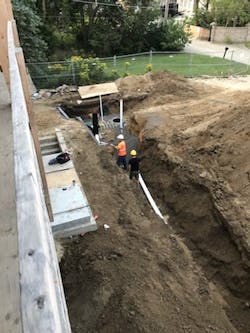About the author: Sam Morrison is a partner with Cleanflo Water Technologies. Morrison can be reached at [email protected] or 877.306.2146.
Cleanflo Water Technologies was contacted by design-build architectural firm Noar.ca Inc. and engineering firm Elmid Designs to design and install a rainwater harvesting system on a residential property in the Richmond Hill area in Ontario, Canada. These three entities provide water conservation solutions for the greater Toronto area.
The homeowners wanted to collect rainwater for water conservation in their home, and also to meet the city’s requirements for onsite storm water management.
Site Analysis
The first step in creating a system is developing an adequate design. Cleanflo Water Technologies started by conducting a detailed site analysis. The company uses software to simulate rainfall events and generate a hydrologic model for the property to determine how a system will perform.
By analyzing 55 years of location-specific rainfall data, the company can determine the potential volume of rainwater that is actually usable based on rainwater data, rainwater demand and tank size.
In real world scenarios, you never can reach “maximum potential,” as there is loss from the roof, prefilter and tank overflow events. Furthermore, the size of a tank and daily water use play important roles in determining how much rainwater can be collected and used. Actual usable rainwater forms the basis for determining return on investment. Tanks are the most costly item in a rainwater harvesting system, so determining the smallest tank size that will collect the most water based on the criteria described above will significantly impact the total cost of a system.
All daily rainfall data was obtained from Environment Canada at 397 stations across the country for 55 years, from 1955 to 2010.
An essential element in rainwater harvesting system design is the water demand. The use of improper water figures can result in either the system being unable to consistently meet daily water demand of users, requiring the tank to be topped up from a secondary water supply, or wasteful capital investment in the case of an over-designed cistern. In either situation, it is critical that the water demand value employed in the design process be as representative as possible.
There are two methods to determine the water demand: historical records or meter readings that provide an accurate measurement of past water demand; and estimated future water demand based on usage type, number of occupants and days used per week.
The system is projected to harvest 250 cu meters of rainwater each year.
Desigining the System
The next step was to design the system based on the results of the analysis. Cleanflo prepared a complete design set and a quote for a system of approximately $12,500, which the client accepted. The system included a 1,000-gal water cistern; six 1-ft sections of manway to provide access to the buried tank; a self-cleaning rainwater prefilter for 4-in. PVC downpipe due to the size of the required downpipes, low maintenance requirements and high surface area of rainwater catchment; and a 1.25-hp submersible on-demand water pump with float control in the rainwater cistern to supply the irrigation system.
The installation took place in September 2017, over the course of four days, beginning with the excavation. The water cistern pit was dug to a depth of 4 ft of ground cover. This was later filled with high-performance bedding, the material specified by the tank manufacturer.
Next, the downpipe outlets, piping, rainwater prefilter and overflow were roughed in and routed to and from the water cistern. After the piping was in place and buried, the tank manways were installed and the tank was backfilled appropriately. The installation did not experience major problems, and the system has since performed as expected.
Savings Success
The analysis predicted that the system could harvest 250 cu meters of usable rainwater every year. Of that volume, approximately 170 cu meters would be lost in overflow events because the tank was already full. Supplying the household with approximately 80 cu meters of rainwater per year, at $3.6225 per cu meter, with a 5% increase per year, would save the household approximately $289.80 in the first year and $890 on the payback year.
While the approximate payback period for this project was 22 years, the actual savings to the community and environment was undoubtedly larger, and the cost of water will likely rise in coming years, possibly shortening the payback period significantly.
Homeowners will more often find a need for storm water retention systems as they continue to build homes with impermeable surfaces, while cities continue to pass bylaws regarding maximum storm water runoff and water rates continue to rise.
